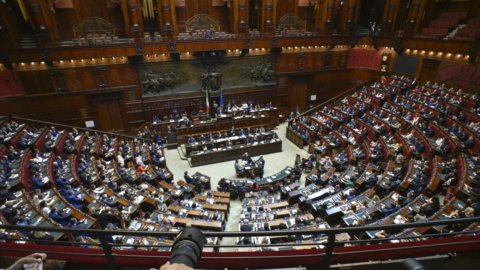La the bill on the reduction of parliamentarians was definitively approved by the Chamber. "The most awaited and promised of the last decades, an obligatory choice to restore credibility to the institutions": thus the rapporteur Giuseppe Brescia (M5S), who opened the final discussion, presented to his colleagues one of the flagships of the 5 Star Movement, also supported by the Premier Conte. The definitive green light was approved by an overwhelming majority: 553 Yes, 14 No and 2 abstentions. With the constitutional reform, the face of the Italian Parliament will change radically.
PARLIAMENTARY CUT: WHAT THE REFORM PROVIDES
The law linearly cuts the number of senators and deputies. In Montecitorio it goes from 630 to 400 deputies, in Palazzo Madama from 315 to 200 senators. In all there will be 600 MPs, today they are 945: in percentage terms it is a decrease of 36,5%.
The number of MPs in the foreign constituency will also be reduced: from the current 12 to 8 deputies, from 6 to 4 senators. The minimum number of parliamentarians that each Region can elect drops – from 7 to 3 – without prejudice to the fixed quotas of Molise (2 parliamentarians) and Valle d'Aosta (1 parliamentarian).
Making some calculations, with this reform Italy will have one MP elected for every 151 inhabitants (today there are 96.006) in Montecitorio, one for every 302 inhabitants (today 188.424) in Palazzo Madama, becoming the European country with the smallest Parliament in proportion to the population. United Kingdom, France and Germany, to be clear, have one parliamentarian for every 100-110 thousand inhabitants.
The new structure will enter into force when the President of the Republic (Mattarella or his successor, depending on the timing) dissolves the Chambers in view of new elections or, alternatively, after "the first termination of the Chambers following the date of entry into force of the constitutional reform".
PARLIAMENTARY CUT: HOW MUCH YOU SAVE
Currently House and Senate together cost 1,5 billion a year and, it must be said, the savings guaranteed by this reform are rather meager despite the electoral propaganda of the parties. In any case, the figures provided by the 5 Star Movement are different from those disclosed by the Observatory of Public Accounts. For the party led by Luigi Di Maio, 100 million savings a year will come from the cut in parliamentarians, which therefore become 500 in the 5 years of the legislature.
According to the technicians of the observatory, however, the figures provided by the Five Stars should be divided by two and therefore would be spent 57 million a year less, 285 per legislature.
PARLIAMENTARY CUT: A REFERENDUM IS NEEDED?
The vote of the Chamber of 8 October was the fourth and final step before definitive approval. In the Senate in the third reading, the ok came with a simple majority. In the meantime the Lega-M5S Government has fallen and the new PD-M5S Executive has arrived.
Secondo article 138 of the Constitution, "a referendum does not take place if the law has been approved in the second vote by each of the Chambers with a majority of two thirds of its members". Which means that regardless of the numbers obtained in the Chamber, there are the conditions to hold a referendum.
In the three months following its publication in the Official Journal it could be presented a request for a confirmatory referendum, the same type of referendum to which the constitutional reform wanted by the then Premier, Matteo Renzi, was submitted in December 2016, so to speak.
A fifth of the members of one of the two chambers, 500 voters or five regional councils can apply for a referendum. The referendum does not require a quorum and in order for the law to pass, it will need a majority of valid votes.
PARLIAMENTARY CUT: WHAT HAPPENS NEXT
The approval of the constitutional reform bill will cause chain reactions. Adjustments will be needed which will be discussed in the coming months and which have been indicated by the PD (previously opposed to the cut) as essential to guarantee its vote in favor of the measure in the Chamber.
There is already some sort of roadmap. By the end of this month, the amendments to extend the election of the Senate to 18 year olds (currently limited to over 25s).
By December, the reform proposals will be presented to change the part of the Constitution that establishes the election of the Senate on a regional basis and to change the number of regional delegates who participate in theelection of the President of the Republic.
By the end of the year it will be presented by the majority parties proposal to reform the current electoral law. The most probable hypothesis is that we arrive at a pure proportional with a barrier threshold.





